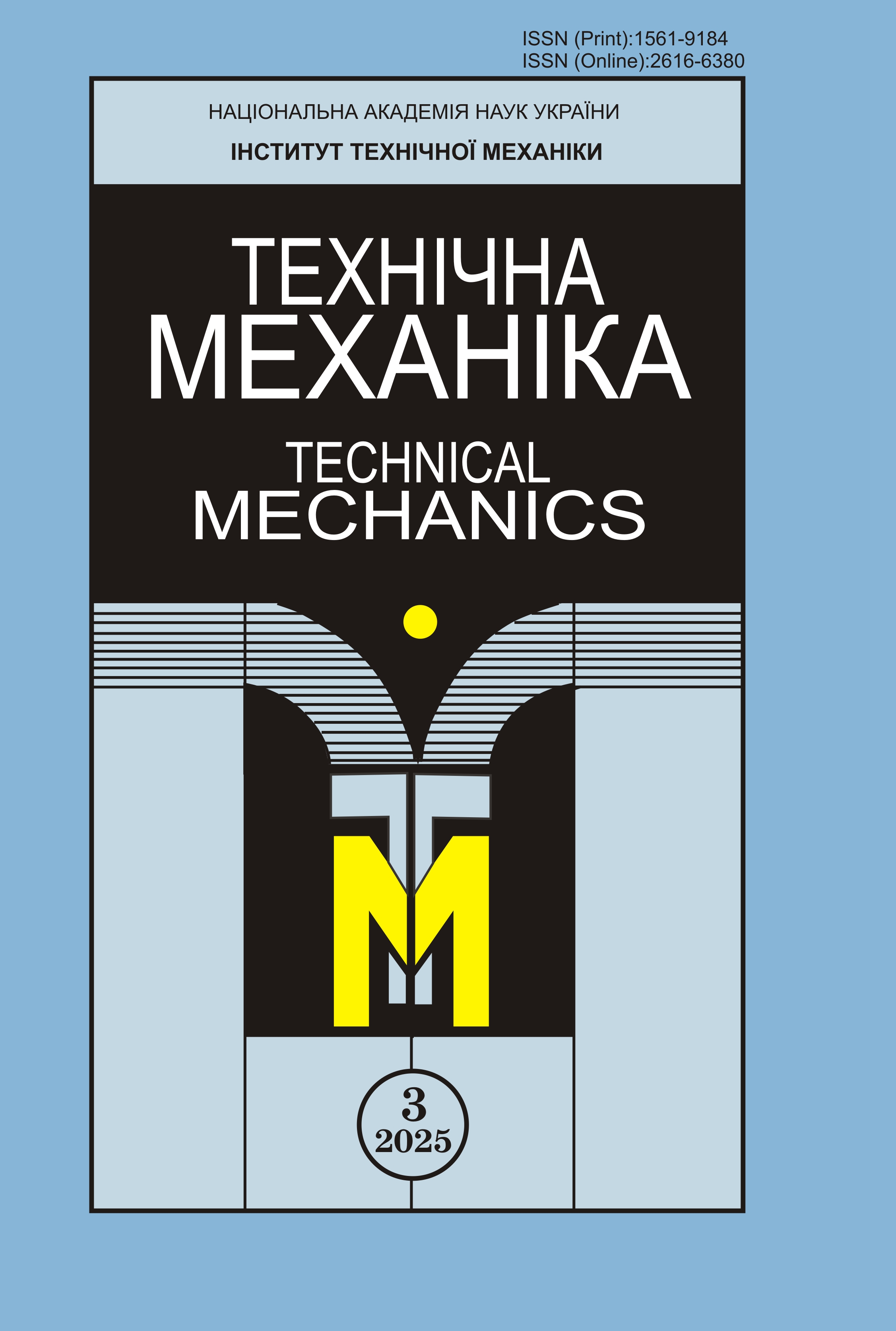FEATURES OF THE STRENGTH ANALYSIS OF BOLTED CONNECTIONS BETWEEN LAUNCH VEHICLE COMPARTMENTS
Keywords:
flange connection; launch vehicle compartment; frame; analytical model.Abstract
DOI: https://doi.org/10.15407/itm2025.03.003
This work is devoted to the study of the features of the deformation of bolted flange connections of launch vehicle compartments and the determination of failure loads thereon. The goal of the work is to study problematic issues of the correct choice of an analytical model for flange connections of individual compartments. A method for determining the ultimate load on a bolted connection is presented. Finite element analysis methods were used. The calculations meet all the requirements adopted in the field of bolted connection strength standards. Relevant safety factors are also used. Account is taken of bolt thread stripping, unloading sleeve shearing, the bolt tightening force simulated by the introduction of corresponding temperature loads, and other connection member parameters. The results of full-scale destructive tests of the flange connection of the end frames of individual compartments are analyzed. A discrepancy between the calculated results and the test data is found out. It is shown that the discrepancy is due to an insufficiently correct consideration of the design features of the connections and the action of external loads, which led to additional components of eccentric tension-compression. It is demonstrated that the destructive load calculated with account for the “force lever” predictably proved to be smaller than that calculated in the assumption of a rigid frame and close to the full-scale test data. The article also presents the results of a numerical finite element study of the sensitivity of calculated results to variations in the principal bult connection parameters: the bolt tightening forces, the unloading sleeve diameter, the constructive offset of the bolt axes to the middle surface of the compartment shell, etc. The results obtained may be useful as a scientific and methodological basis for the correct choice of analytical models for flange connections of launch vehicle compartments.
REFERENCES
1. Balabukh L. I., Alfutov N. A., Usyukin V. I. Structural Mechanics of Rockets. Moscow: Vysshaya Shkola, 1984. 496 pp. (In Russian).
2. Beitsun V. S., Dziuba A. P. Experimental study of the flexibility of flange connections in a space manipulator model. Problems of Computational Mechanics and Strength of Structures. 2024. Iss. 38. Pp. 5–19. (In Ukrainian).
3. Beitsun V. S., Tarasov S.V. Methodology for photogrammetric measurement of backlashes and elastic compliances in hinge joints of transport manipulators and spacecraft booms Teh. Meh. 2024. No. 3. Pp. 124–137. (In Ukrainian).
https://doi.org/10.15407/itm2024.03.124
4. Bondarenko D., Krivoruchko A., Khorolskiy P. The development of effective systems for connecting and separating of compartments. Journal of Rocket-Space Technology. 2020. No. 28(4). Pp. 14–20. (In Ukrainian).
https://doi.org/10.15421/452002
5. Degtyarev A. V. Rocket Technology. Problems and Prospects. Dnipropetrovsk: ART-PRESS, 2014. 420 pp. (In Russian).
6. Dziuba A. P., Dziuba O. A., Sirenko V. M. Investigation of the sensitivity of the results of calculating the strength of structural elements to variations in input data. Problems of Computational Mechanics and Strength of Structures. 2024. Iss. 39. (In Ukrainian).
7. Lizin V. T., Pyatkin V. A. Design of Thin-Walled Structures. Moscow: Mashinostroyeniye, 1976. 408 p. (In Russian).
8. Manko T. A., Litot A. V. Use of modern software packages in the design and manufacture of carbon fiber propellant tank flanges. System Design and Performance Analysis of Aerospace Hardware. Dnipro: Lira, 2019. Pp. 90–94.
9. Mikulnyk I. O., Karvatskyi A. Ya., Ivanenko O. I., Leleka S. V. Flange connections of equipment and pipelines of chemical technology. Bulletin of NTUU "Igor Sikorsky Kyiv Polytechnic Institute". Series: Chemical Engineering, Ecology and Resource Conservation. 2023. No. 2(22). Pp. 15–31. (In Ukrainian).
10. Mossakovsky V. I., Makarenkov A. G., Nikitin P. I., Savvin Yu. I., Spiridonov I. N. Strength of Rocket Structures. Moscow: Vysshaya Shkola, 1990. 360 pp. (In Russian).
11. Kharchenko V. Modeling and determination of the stress state of joints of rocket structures made of composite materials. Applied Problems of Mechanics and Mathematics, 2017. Iss. 15. Pp. 185–190. (In Ukrainian).
12. Kharchenko V., Klymenko D. Stress loading of rocket joints taking into account the structural features of adjacent compartments. Applied Problems of Mechanics and Mathematics. 2019. Iss.17. P. 98–104. (In Ukrainian).
https://doi.org/10.15407/apmm2019.17.98-104
13. Dzyuba A., SirenkoV. Substantiation of reliability of calculation of strength of rocket and space technology structures without destructive tests. Advances in Mechanics. Current Research Results of the NAS of Ukraine. Chapter 12. A.N. Guz, H. Altenbach, V. Bogdanov, V. M. Nazarenko (Eds.). Cham: Springer, 2023. Pp. 212–222.
https://doi.org/10.1007/978-3-031-37313-8_12
14. Zienkiewicz O. C., Taylor R. L., Zhu J. Z. The Finite Element Method: Its Basis and Fundamentals. Sixth edition. Butterworth-Heinemann, 2016. 753 pр.






